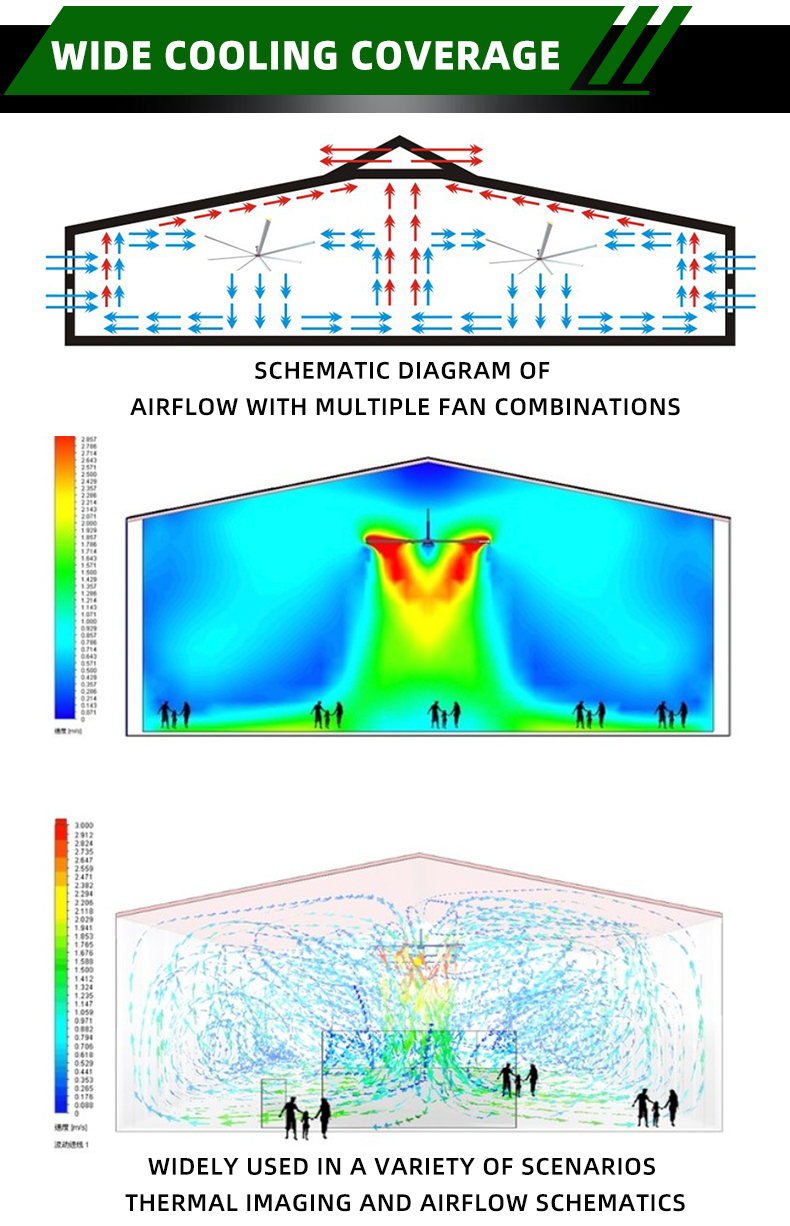În fabricile de astăzi, este esențial ca angajații să beneficieze de condiții bune de muncă și factorii externi să nu interfereze cu procesele. Atributele cheie pentru o muncă eficientă includ calitatea aerului. Din acest motiv, tehnologia utilizată în ventilatoarele de tip rooting a devenit din ce în ce mai eficientă. Scopul acestui eseu este de a investiga modul în care ventilatoarele HVLS îmbunătățesc cu succes aerul interior, precum și avantajele și designul lor.
Ventilatoarele HVLS sunt destinate să fie eficiente în mișcarea unor volume mari de aer la viteze mici pentru a genera o briză în spațiile unde răcirea este necesară în vreme blândă. Ventilatoarele HVLS sunt concepute pentru a distribui aerul în întreaga cameră, mai degrabă decât într-o singură locație, ca în cazul ventilatoarelor individuale. Pe lângă îmbunătățirea confortului, distribuția uniformă a aerului într-o cameră ajută, de asemenea, la minimizarea șanselor ca aerul să fie stagnant, ceea ce ar facilita creșterea poluanților și alergenilor. În acest fel, ventilatoarele HVLS gestionează eficient fluxul de aer pentru a preveni concentrarea contaminanților din aer și a îmbunătăți calitatea aerului.
În plus, ventilatoarele HVLS sunt foarte importante când vine vorba de consumul de energie. Cele mai comune sisteme HVAC sunt de obicei extrem de suprasolicitate deoarece încearcă mereu să livreze temperatura solicitată, crescând astfel costul energiei. Cel mai important, spre deosebire de aceste sisteme, ventilatoarele HVLS creează un efect de vânt rece care reduce șansele de suprasolicitare a acestor sisteme în primul rând. Ele permit facilităților să crească termostatele în timpul lunilor mai calde, ceea ce duce la costuri de energie mult mai mici. Prin urmare, utilizarea ventilatoarelor HVLS în aplicații industriale îmbunătățește cu siguranță obiectivele de dezvoltare durabilă și țintele de responsabilitate corporativă.
Ventilatoarele HVLS sunt de asemenea foarte utile în creșterea moralului angajaților datorită reducerii costurilor energetice, în timp ce în același timp cresc producția angajaților. Există multe dovezi susținute de studii care indică faptul că un mediu de lucru bun are un impact pozitiv asupra concentrării și nivelurilor de productivitate în rândul lucrătorilor. Aceștia folosesc ventilatoare HVLS care oferă o calitate bună a aerului și controlul temperaturii, ajutând angajații să performeze. În plus, o calitate mai bună a aerului poate reduce numărul de cazuri de boli respiratorii și alte afecțiuni, conducând la mai puține zile de boală și o forță de muncă mult mai eficientă și sănătoasă.
Industria continuă să inoveze în ceea ce privește ventilatoarele HVLS, inclusiv caracteristici de design, precum și sisteme de control. Pe măsură ce tehnologia devine mai disponibilă, se produc ventilatoare HVLS eficiente care utilizează sisteme de control al fluxului de aer, ajustând nivelul de aer în funcție de condițiile externe. Datorită acestui fapt, mișcarea aerului devine nu doar utilă, ci și optimizată și maxim benefică în utilizarea ventilatoarelor HVLS în aplicații industriale. În plus, mulți producători vizează materiale ecologice și motoare eficiente din punct de vedere energetic, ceea ce va face posibilă considerarea ventilatoarelor HVLS ca o soluție de economisire a energiei.
În concluzie, există multe industrii în care ventilatoarele HVLS ar trebui să fie utilizate pentru a îmbunătăți calitatea aerului. Capacitatea lor de a mișca aerul și eficiența în consumul de energie, în timp ce cresc productivitatea lucrătorilor, reprezintă o piesă esențială pentru orice facilități. Cu mai multe industrii care adoptă măsuri de sănătate și siguranță alături de practici de sustenabilitate, nivelurile de penetrare a ventilatoarelor HVLS în afacerile industriale sunt setate să crească, creând o nouă normă pentru gestionarea calității aerului în birouri. Aplicarea acestor tehnologii de ventilatoare este probabil să ajute afacerile să rămână în pas cu schimbările din industrie, cum ar fi creșterea nivelurilor de calitate a aerului interior și eficiența energetică.
 EN
EN
 AR
AR
 BG
BG
 HR
HR
 CS
CS
 NL
NL
 FI
FI
 FR
FR
 DE
DE
 EL
EL
 IT
IT
 KO
KO
 NO
NO
 PL
PL
 PT
PT
 RO
RO
 RU
RU
 ES
ES
 SV
SV
 ID
ID
 LT
LT
 SR
SR
 UK
UK
 VI
VI
 HU
HU
 TH
TH
 TR
TR
 FA
FA
 MS
MS
 HY
HY
 AZ
AZ
 KA
KA
 BN
BN
 LO
LO
 LA
LA
 NE
NE
 MY
MY
 KK
KK
 KY
KY


 ONLINE
ONLINE